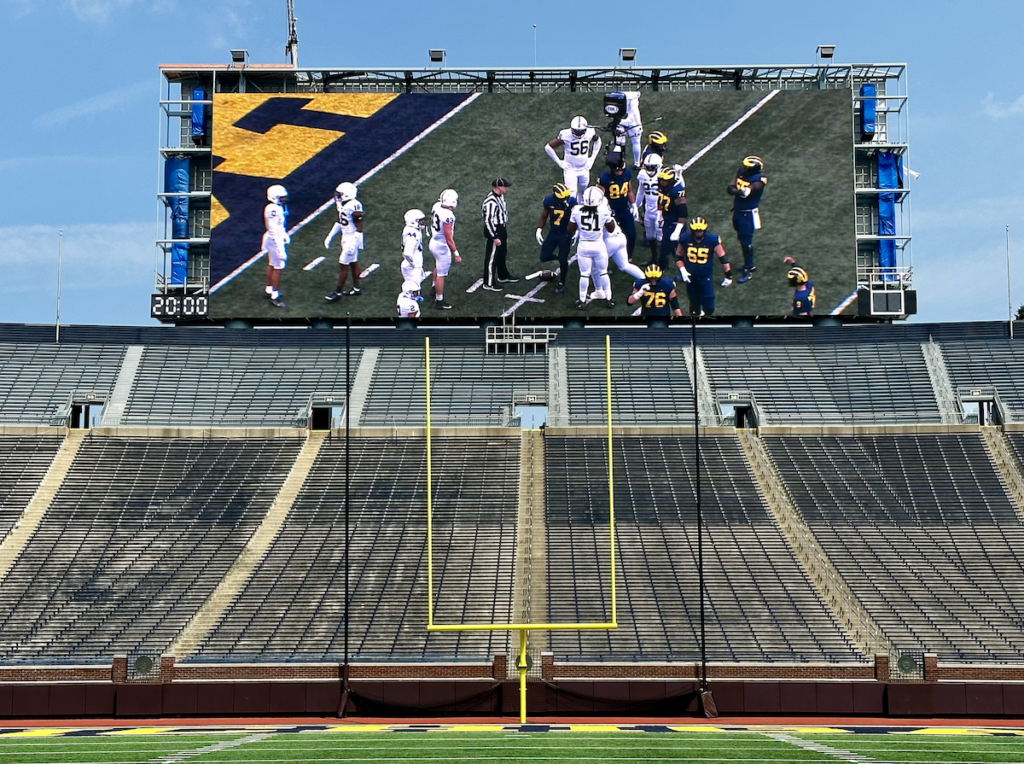Michigan Stadium scoreboard update: Progress report, facts and more
Members of the Michigan media contingent were granted an inside look at the progress of the new scoreboards going up at the Big House on Wednesday. The enhancements, which are on track to be ready to roll on Sept. 2, may go a long way in improving the fan experience at Michigan Stadium.
Construction on the new videoboards began the Monday after the Illinois game on Nov. 19. Crews have been putting in work perpetually since the final home game was played last season. As of Wednesday afternoon, work on the north scoreboard was nearly complete with the south board being the next area of focus.
The structures that support the boards in both end zones measure 179 feet by 62 feet, an 85% increase in size from the previous boards (109 feet by 50 feet). The videoboards themselves measure in at 152 feet by 55 feet, an 118% increase from what was there before (85 feet by 45 feet). The boards contain 135 video cabinets that weigh between 400 and 800 pounds.
Two additional pillars were added to the support structures, measuring around 12 feet in diameter. Over 5.5 miles of new cable have been run through the boards as part of the 35,000-plus hours of labor done so far.


The size of each board is the third largest in college football behind Auburn and Purdue, respectively, though both of those stadiums have only one board. Michigan has two structures on both the north and south endzones. The video boards are manufactured by Mitsubishi, known best for their work at AT&T Stadium in Arlington, Texas. The boards are capable of 4K and 8K resolution, but depends on the broadcast source.
The border around the screen will be blue with Block M’s and “Michigan Stadium” adorning the top of that. Work on that had not begun as of our tour on Aug. 2. Ads will not be incorporated into the board.
In addition to the new boards, the sound system in Michigan Stadium has also been upgraded. New speakers have been installed on the concourse in addition to a new sound system inside of the north scoreboard. The hope is for a more balanced – and hopefully louder – sound experience inside the building.
Top 10
- 1Hot
Who's enrolling early?
Michigan breakdown
- 2
Hoops conversations
What we learned from players, coaches
- 3
Impact signees
Projecting 2026 class roles
- 4
Signing day superlatives
Here's who makes up the 2026 class
- 5
'Baddest dude'
Breaking down Brady Marchese
Get the Daily On3 Newsletter in your inbox every morning
By clicking "Subscribe to Newsletter", I agree to On3's Privacy Notice, Terms, and use of my personal information described therein.
LED lights were also installed as part of the new project, but it will be determined soon how they will be integrated into the gameday experience. The plan is for the audio and video elements to be fully tested sometime next week. Training behind the scenes has been underway for those in charge of the video and lighting functions.
As far as on-screen elements go, Michigan plans on showing more in-game statistics than ever before in addition to more frequent updates on out-of-town scores. With most having spotty cell service inside the stadium, officials hope that more information available on-screen can help offset a lack of access to data via mobile devices. In-stadium WiFI is not part of the renovations to the Big House but could come at a later date.
The fan experience is at the center of the upgrades on campus and was budgeted as a $41 million fix. The work also includes upgrades to the production studio in Crisler Center that powers events at most athletic facilities on campus, as well as producing content for the Big Ten Network. Because the project came in under budget, soccer, field hockey, the baseball and softball complex and Cliff Keen arena will also get new video boards. No word was given on when video board upgrades would happen for Crisler Center and Yost Ice Arena.
Michigan last upgraded its video boards ahead of the 2011 season and lasted for 11 years. The new boards are expected to have a similar lifespan.
All of the work is expected to be functional by the time Sept. 2 rolls around with some touchups and tweaks happening in the weeks that follow.